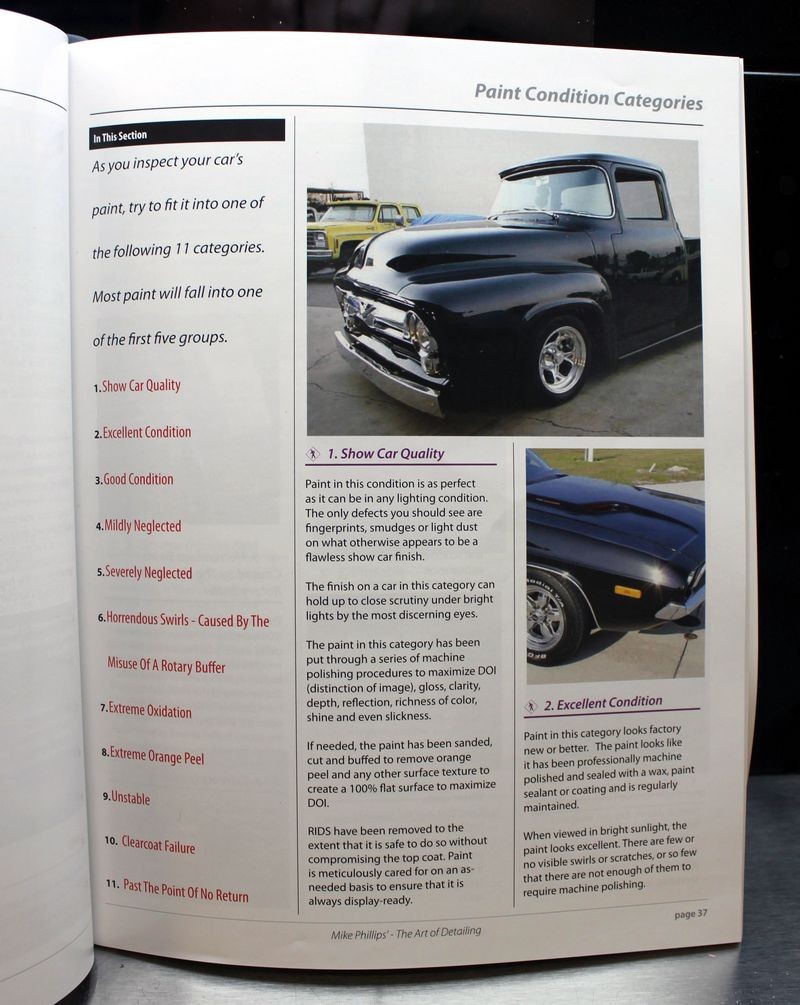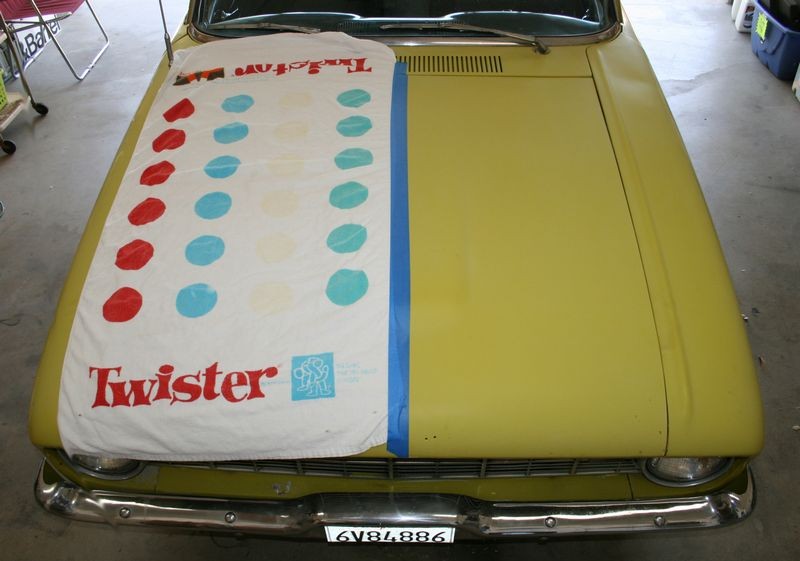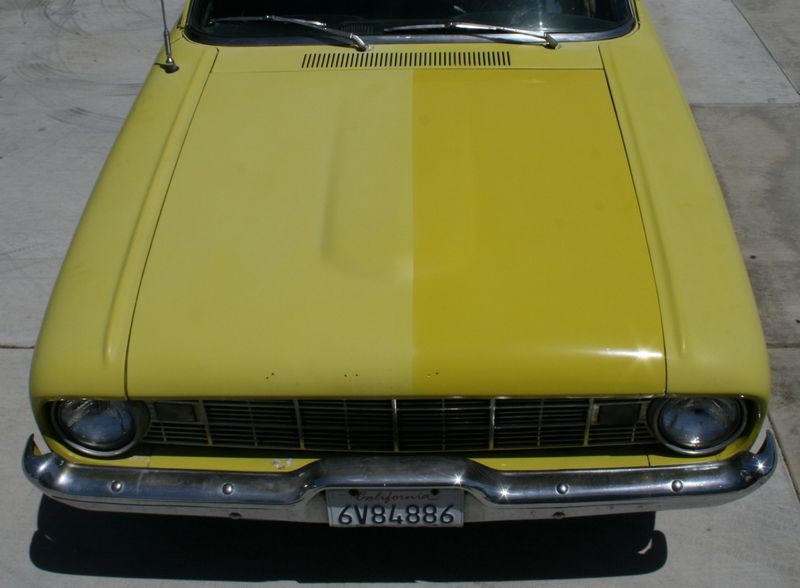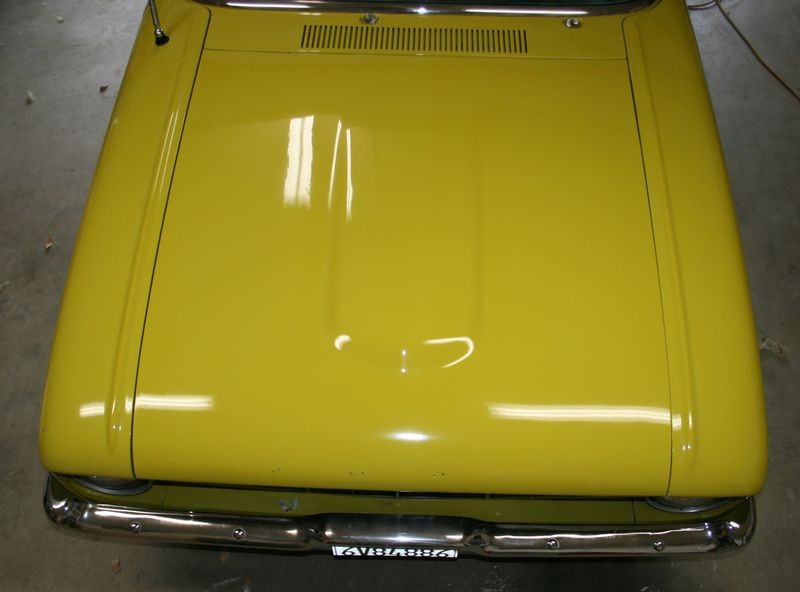 Thanks: 0
 Dislikes: 0
-
Re: Hand "buffing" older car
And just to add....
Rubbing down a car by hand is physical hard work, even for someone in good shape. I don't know what kind of shape you are in so just be aware of this heading into the project.
For example, plan for and tackle this type of project on our day off staring early in the morning when you're fresh and full of energy. If you're not in great shape, consider tackling just a panel or two at a time.
In fact, if you've never done this type of polishing before, maybe just do the hood or trunk lid to start with. Besides giving you a taste of what it's going to be like to tackle the entire car, by only tackling the hood you'll find out real fast if this product (#7 Show Car Glaze), is going to save the paint or not.
Sometimes, the pigments in paint become unstable and cannot be saved. Sometimes the paint is past the point of no return and cannot be saved. By testing on just the hood or trunk, (usually the worst condtion panels), you'll find out if the paint can be saved and if it cannot then you'll save yourself a lot of time since you'll know not to continue.
My guess is the paint can be saved as old lacquers and enamels from the old days we're really GREAT paints.
Here's this.... it's also in my how-to book, "The Complete Guide to a Show Car Shine". See categories 9 and 11
Paint Condition Categories
Page 37 - Paint Condition Categories

Using the guide below, inspect the paint on your car or cars, trucks, SUVs, etc. And then post which category you think each vehicle matches.
1: Show Car Quality
Paint in this condition is as perfect as it can be in any lighting condition. The only defects you should see are fingerprints, smudges or light dust on what otherwise appears to be a flawless show car finish.
The finish on a car in this category can hold up to close scrutiny under bright lights by the most discerning eyes.
The paint in this category has been put through a series of machine polishing procedures to maximize D.O.I, gloss, clarity, depth, reflection, richness of color, shine and even slickness.
If needed, the paint has been sanded, cut and buffed to remove orange peel and any other surface texture to create a 100% flat surface to maximize D.O.I.
RIDS have been removed to the extent that it is safe to do so without compromising the top coat. Paint is meticulously cared for on an as needed basis to ensure that it is always display ready.
2: Excellent Condition
The paint in this category looks factory new or better than factory new.
The paint looks like it has been professionally machine polished and sealed with a wax, paint sealant or coating and is regularly maintained.
When viewed in bright sunlight, the paint looks excellent, that is there are few or no visible swirls or scratches or so few that there's not enough of them to require machine polishing.
The paint has few or no swirls, scratches or any other visible paint defects outside of RIDS.
3: Good Condition
Light swirls, scratches, water spots and oxidation.
When viewed in bright sunlight, the paint should look pretty good overall except that it has light or shallow looking cobweb swirls and scratches throughout the paint. Any water spot problems should be shallow imprint type stains common to Type I Water Spots, certainly not deep craters like Type II or Type III where the paint is physically stained.
Paint in this condition would require one or two polishing steps before a finishing wax could be applied to bring the quality to Excellent or Show Car Quality.
4: Mildly Neglected
Normal day-in, day-out wear-n-tear and minimal appearance maintenance outside of the occasional car wash. Paint in this condition has medium to light swirls, scratches, water spots and oxidation.
Cobweb Swirls and Scratches
When viewed in bright, overhead sunlight there are cobweb swirls and scratches evenly instilled throughout the entire finish but they're likely instilled through improper washing and drying techniques, which means the depth of these defects won't be as deep as the swirls and scratches in a severely neglected finish. The swirls are not inflicted by a rotary buffer. The remedy is still the same except you might be able to use a less aggressive pad or product.
Water Spots
Paint with Type I Water Spots or shallow Type II Water Spots that are more imprints than they are craters falls into this category.
Oxidation, Staining and Surface Impurities
If the car being evaluated is a daily driver, is parked outside 24/7 and has not been regularly polished and/or waxed for a few years then chances are good it has light oxidation and staining of the paint with some type of roadgrime or a build-up of impurities or some type of topical contamination that does not wash or wipe-off.
5: Severely Neglected
Paint in this condition has deep swirls, scratches, water spots and oxidation. Paint in this condition has normal day-in, day-out wear-n-tear plus no real regular maintenance. Vehicles in this category are rarely washed on a regular basis and when they are washed they are washed improperly or taken through automatic car wash.
Cobweb Swirls and Scratches
Paint that is severely neglected means that when viewed in bright, overhead sunlight, there are so many swirls and scratches that the paint has an overall hazy appearance which blocks your view of the true color.
Water Spots
Paint that is in the severely neglected category can have Type I, Type II and Type III water spots on all horizontal panels and even the vertical panels if caused by a sprinkler or some type of water spray.
Severe Oxidation
Paint in this category has oxidized to the point where the surface has a uniform dull appearance to the horizontal surfaces and to some extent the vertical panels. Clear coats do oxidize but usually slower than single stage paints and don't normally get the whitish, chalky appearance with a rough texture common to old, neglected single stage lacquers and enamels.
6: Horrendous Swirls - Caused by the misuse of a rotary buffer
This category is primarily for cars that have been improperly buffed-out using a rotary buffer leaving the finish inflicted with rotary buffer swirls, holograms or buffer trails.
(Whatever term you like, they all mean the same thing).
The severity of the swirls can range from shallow to deep depending upon the pad and product used with the rotary buffer as well as technique or lack thereof.
The normal three culprits for paint in this condition are,
Dealer Installed Swirl Option
Bodyshop Installed Swirl Option
Detailer Installed Swirl Option Sad but true, the people in this industry that are supposed to know how to properly buff out a car normally either don't know or don't care. The results are the same and that's a swirled out car finish that someone else will have to undo.
7: Extreme Oxidation
Paint is this category is primarily associated with traditional single stage lacquer and enamel paints and normally found cars built before 1980. Extreme Oxidation means the paint has deteriorated to the point that it has a chalky, whitish appearance.
Paint in this category is typically antique or original. It can be a re-paint, but it would be an older re-repaint. Paint with extreme oxidation can be saved by carefully removing the dead, oxidized paint and rejuvenating with polishing oils the remaining paint. After polishing the color is restored and remains even when exposed to sunlight. If the color fades away then this is an indicator that the paint has become unstable.
8: Extreme Orange Peel
Paint in this category is primarily re-paints from body shops, dealerships or do-it-yourselfer garage paint jobs. It doesn't normally include factory orange peel because factory orange peel is a given for new cars and truck and due to how thin the top coat is on a factory paint job there's a certain amount of risk you have to accept if you choose to remove the factory orange peel while re-paints will tend to have enough material that the problem can be safely corrected via sanding and buffing.
9: Unstable
This category is for older, single stage paints that have been exposed to the sun for a long enough period of time that the pigments have become unstable. That is even if you remove the oxidation and gorge the paint with some type of polishing oils, any original color that is restored is only a temporary fix and when the paint is exposed to the sun or after a few days pass the color fades back to where it was before you started.
10: Clear Coat Failure
Clear coat failure is the point in which the top clear layer of paint has either de-laminated from the basecoat and is peeling off. Clear coat failure can also be when the clear layer of paint has deteriorated to the point where it's turning a whitish color in the beginning stages to full blown deterioration where it has turned white and is flaking off and the car look like it has a severe rash.
11: Past the point of no return
Paint in this condition will be a paint job that falls into one of the above categories but it is so far gone that nothing you pour out of a bottle or scoop out of a can from any company will fix it.

-
Post Thanks / Like - 0 Thanks, 2 Likes, 0 Dislikes
-
-
Post Thanks / Like - 0 Thanks, 2 Likes, 0 Dislikes
-
Re: Hand "buffing" older car
How would you prep wash the car first and what kind of wash product would you use Mike? So you get the most dirt of the paint if it has been driven alot before.
Works hybrid wax good as a natuaral wax? Or is it even ok to apply a sealant to nice single stage paint?
Thanks for the detailed answers about rubbing in #7!
-
Re: Hand "buffing" older car
 Originally Posted by SWETM

How would you prep wash the car first and what kind of wash product would you use Mike? So you get the most dirt of the paint if it has been driven alot before.
Any brand name waterless wash or spray detailer would be sufficient to remove any loose dirt. That and some terry cloth hand towels. I wouldn't use something like high quality microfiber towels as this is really some dirt-work. The big picture is to simply remove any loose dirt or contaminants so you don't rub them into the paint when rubbing the #7 into the paint.
 Originally Posted by SWETM

Works hybrid wax good as a natuaral wax? Or is it even ok to apply a sealant to nice single stage paint?
Thanks for the detailed answers about rubbing in #7!
Basically any quality hybrid, carnauba or even synthetic sealant would work. As long as it's low in solvent it will tend to be fine. Pinnacle Signature Series II or Pinnacle Souveran, both the paste and the liquid all work great.
Meguiar's #26 in both paste or liquid work great as does Meguiar's #20 Polymer Sealant.
P21S would work great so would any of the Collinite non-cleaning waxes. Mothers California Gold Carnauba Wax in both paste or liquid, the pure version, not the cleaner/wax.
I have an all original paint 1957 Chevy coming up in January. The paint on this car is NOT oxidized, it's actually very smooth and shiny. The owner says he's having a hard time finding a wax that doesn't dull down the black paint. Stay tuned for this project.
Saturday Project - Polishing and waxing original antique paint - 1957 Chevy 210

We will be rubbing the original paint on the 1957 Chevy down with #7 but the technique for this is very different than when the paint is dull and chalky.
Stay tuned...

-
Post Thanks / Like - 0 Thanks, 2 Likes, 0 Dislikes
-
Re: Hand "buffing" older car
Nice to see what you are going to do. And one of my favorite car also  Will certainly follow that! Will certainly follow that!
Thanks for the answers. I was writing my post while you was too. So read that now about lsp you added.
Have read about that some waxes and sealants lower the gloss a little when measured with a gloss reader instrument on black paints.
-
Super Member

Re: Hand "buffing" older car
Lordy Mike...some really good stuff here! And timely as well. I will be doing a Grand National with a 30 year old lacquer paint. It was left outside under trees for about 3 years before storing in the garage. Paint is very dry and parched. Plan to do the multi step using meguires # 7. I can't wait to get on this! Told the owner I'll do everything to save the paint. Also warned him that without checking/testing, the paint could be unstable and beyond saving. My gut says it can be saved...finger crossed.
After reading your write up, I realized I need to change my approach of applying and quickly removing #7 at the first step to cut and remove the oxidized paint. I will instead just put down the initial application and let it sit for 24 hours.
Thanks for this valuable information! I needed that!
Tom
Mr Tommy's
Wash, Buff, Wax
Website: mrtommyshine.com
-
Post Thanks / Like - 0 Thanks, 1 Likes, 0 Dislikes
-
Super Member

Re: Hand "buffing" older car
 Originally Posted by TMQ

Lordy Mike...some really good stuff here! And timely as well. I will be doing a Grand National with a 30 year old lacquer paint. It was left outside under trees for about 3 years before storing in the garage. Paint is very dry and parched. Plan to do the multi step using meguires # 7. I can't wait to get on this! Told the owner I'll do everything to save the paint. Also warned him that without checking/testing, the paint could be unstable and beyond saving. My gut says it can be saved...finger crossed.
After reading your write up, I realized I need to change my approach of applying and quickly removing #7 at the first step to cut and remove the oxidized paint. I will instead just put down the initial application and let it sit for 24 hours.
Thanks for this valuable information! I needed that!
Tom
So I take it you won't be doing the Comet thing. LOL.
If you would... Do a small test area using Comet. Maybe a one foot square area in the middle of the roof where even if it F's it up (it won't) it wouldn't stick out like a sore thumb. Then report back on your take. I'd like to retain a little credibility going forward 
-
Re: Hand "buffing" older car
Bunch of great ideas, and I will get going soon. One of the best tips was to take a picture before the work begins to be able to compare the finished product!
-
Post Thanks / Like - 0 Thanks, 1 Likes, 0 Dislikes
-
Re: Hand "buffing" older car
Looking forward to see how your project becomes texczech if you will share that to us. Good luck and take your time!
Similar Threads
-
By saleenman607 in forum Auto Detailing 101
Replies: 11
Last Post: 01-17-2019, 08:09 PM
-
By PS90 in forum Wolfgang Car Care
Replies: 4
Last Post: 04-20-2016, 09:17 AM
-
By Mantilgh in forum Off-Topic
Replies: 1
Last Post: 04-12-2015, 09:42 AM
-
By AndrewBigA in forum Show N' Shine
Replies: 6
Last Post: 08-22-2011, 10:48 AM
-
By MobolWerks in forum Ask your detailing questions!
Replies: 12
Last Post: 03-10-2010, 10:12 PM
 Members who have read this thread: 0
Members who have read this thread: 0
There are no members to list at the moment.
 Posting Permissions
Posting Permissions
- You may not post new threads
- You may not post replies
- You may not post attachments
- You may not edit your posts
-
Forum Rules
|
| S |
M |
T |
W |
T |
F |
S |
| 31 |
1
|
2
|
3
|
4
|
5
|
6
|
|
7
|
8
|
9
|
10
|
11
|
12
|
13
|
|
14
|
15
|
16
|
17
|
18
|
19
|
20
|
|
21
|
22
|
23
|
24
|
25
|
26
|
27
|
|
28
|
29
|
30
| 1 | 2 | 3 | 4 |
|













 Thanks:
Thanks:  Likes:
Likes:  Dislikes:
Dislikes: 

 Reply With Quote
Reply With Quote






Bookmarks